Trucking is one of the most popular modes of transport in the world and is even required when moving cargo via air or ocean freight. The reason why it’s so popular and an extremely important transportation mode is because roads are the most extensive type of infrastructure that allow trucks to easily access places. One of the most popular types of truck is a straight truck.
A straight truck is a type of truck where all axles are connected to a single frame. In other words, the tractor (also called cab) and the trailer or the cargo box are connected to the same frame and cannot be detached.
This concept is different from semi trucks (a type of articulated vehicle) that consists of a tractor or cab, that can be detached from the trailer. With semi trucks, the tractor and the trailer are not part of a single frame and can be detached.
In this article, we’ll be taking a closer look at straight trucks by explaining the various different types, cargo suitability, specifications, costs, benefits, license requirements and much more! Here’s a quick overview of the content that we’ll cover in this article:
- Straight Tuck Definition & Design
- Types of Straight Trucks
- Suitable Cargo for Straight Trucks
- Straight Truck Specifications
- Costs of Straight Trucks
- How to Drive Straight Tucks
- Straight Truck License Requirements
- Benefits of Straight Trucks
What Are Straight Trucks & What Do They Look Like?
Compared to traditional semi trucks which have a separate cab and trailer, straight trucks look like they are made of a single unit (cab and trailer or cargo box combined). There are various types of straight trucks and each one serves a unique purpose.
They also come in a wide range of axle configurations that are known as 4, 6, or 10 wheeler trucks. However, they all have in common that their cargo compartment is attached to the same frame as the tractor.
In fact, straight trucks are the most popular kind of truck, as they can be used for a wide variety of activities such as agriculture, construction, utilities, maintenance, logistics, among many more. Therefore, these types of straight trucks are designed in a certain way that facilitates their purpose.
Moreover, straight trucks can be fitted with a cab, whereby the rear is installed with refrigeration units or special material handling equipment such as a lift gate and aerial platforms. One of the most common types of straight truck is a box truck or cube truck that is used to transport cargo.
Different Types of Straight Trucks
There are a wide range of applications for straight trucks across various industries. While the most popular version is a box truck, there are also many other types. Let’s take a closer look at some of these most common straight truck types:
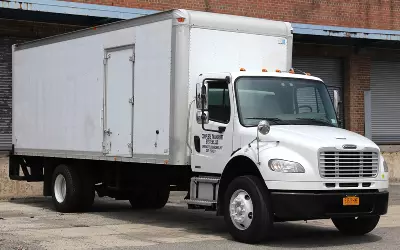
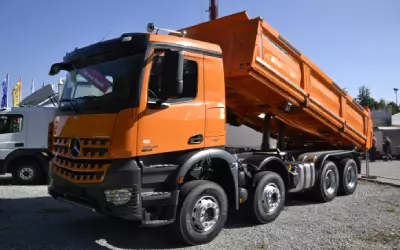
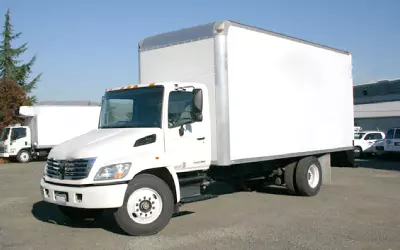

- Box Trucks – Also known as cube trucks or cube vans, the box truck is one of the most commonly found straight trucks. They come in different sizes and their primary purpose is to transport cargo between different locations. These trucks are designed to be fuel efficient, rigid, and reliable, offering fast turnaround time and affordable maintenance. Most transport companies, freight forwarders and even manufacturers use box trucks to transport cargo in between facilities or directly to customers.
- Refrigerated Trucks – Refrigerated straight trucks, also called reefer trucks, are installed with a refrigeration unit. They’re also equipped with a temperature control function that has the ability to regulate temperature within the refrigeration unit. Refrigerated trucks are often used to transport all kinds of chilled or frozen foods, ice, fruits, vegetables, and dairy products. Moreover the use of this truck allows the transportation of medicine and vaccines that require cold storage temperatures. Box trucks play an important role in the growing demand for services connected to the cold chain industry.
- Drop Side Trucks – This type of straight truck has short folding sides, which collapse for easy access, offering efficient unloading and loading activities on both sides of the truck instead of the traditional rear loading. Drop side straight trucks are often seen working in tandem with forklifts for construction and freight forwarding activities.
- Crane Cargo Trucks – Configured almost the same way as drop side straight trucks, cargo crane trucks are equipped with a mounted boom crane used to lift on and off cargo. This crane is extremely versatile and has almost 180 degree maneuverability, which can lift up to several tons of cargo at a time.
- Passenger Van Trucks – These types of trucks are built to carry passengers. Passenger van straight trucks are fitted with seats and typically have a center aisle. These types of trucks are often used in seaports, airports, or other standard offices that require quick and continuous transfer of passengers in larger areas of operations.
- Dump Trucks – Dump trucks are also straight trucks that are designed to transport and offload large volumes of sand, dirt, gravel, and mining waste. Dump trucks are often seen in construction and mining sites and come in various sizes.
- Fire Trucks – Believe it or not, fire trucks (also called fire engines) are also straight trucks, as the tractor unit is attached to the rear section through a single frame. Fire trucks are designed to transport firefighters, water, and firefighting equipment to help combat fire.
- Aerial Platform Trucks – These types of straight trucks are outfitted with a telescopic aerial device to help position personnel on an elevated workspace. They are often used in the service industry and are ideal for maintenance work, repairs and inspections.
- Garbage Trucks – Garbage trucks, also sometimes called refuse collectors, are designed to collect and transport waste. This type of straight truck is fitted with a garbage compactor that compresses waste, in order to increase the overall carrying capacity.
- Tank Trucks – While most tank trucks are semi trucks, tanker straight trucks also exist and are designed to transport gasoline and diesel to gas stations or special facilities.
- Concrete Mixer Trucks – Concrete mixer trucks are also a type of straight truck, as the cab is connected to the cement mixing unit on a single frame. These trucks transport water, aggregate, and cement from batch plants to construction sites.
What Type of Cargo Is Suitable For Straight Trucks?
As straight trucks are used in various industries, it’s common to see them move different types of cargo that are related to logistics, construction, grocery, retail, healthcare and many more. Some specific cargo types include:
- General cargo
- Perishable goods
- Furniture or personal effects
- Various machinery and equipment
- Medicines & Vaccines
- Food items
- Fuel
- Waste
- Building Material
As you can see, straight trucks are extremely versatile and have the ability to transport almost all types of cargo. The reason why straight trucks are so popular is because of their form factor, affordability and ease of maintenance. Let’s take a closer look at the specifications of straight trucks in the next section.
Straight Truck Specifications
Here is a guide on the specifications of a straight truck with regards to dimensions, weight, as well as loading capacity. Take note that straight trucks come in various configurations, mainly as 4, 6, and 10 wheelers and can therefore have varying specifications and features.
Please note that as a general rule, the longer a straight truck is, the larger its maximum loading capacity and volume is. Let’s take a closer look at the specifications.
Straight Truck Dimensions
The overall length of a straight truck is typically determined by the number of axles it has and is calculated by adding the rear and front overhang to the tractor wheelbase.
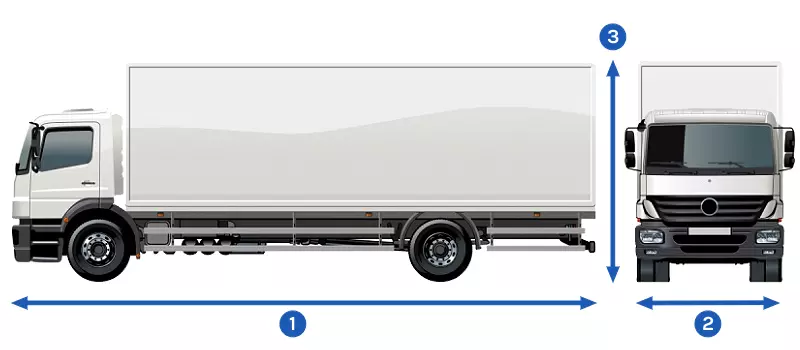
- Length of Straight Truck
- Width of Straight Truck
- Height of Straight Truck
While two axle (4-wheelers) straight trucks have an average length of 15 – 24 feet, a height of 8 – 10 feet and a width from 6 – 8 feet, three axle (6-wheelers) straight trucks can be much longer and taller.
Three axle straight trucks can have a maximum length of up to 60 feet (depending on the state they are operating in, although the average maximum is about 40 – 45 feet), a height of 8 – 10 feet and a width of up to 8.5 feet.
For reference, the average overall length of a standard straight truck is about 26 feet, including tractor wheelbase and both rear and front overhang. Here’s a quick summary:
- Maximum Length for Straight Trucks: 40′ – 60′ (state regulated)
- Maximum Height for Straight Trucks: 13′ – 15′ (state regulated)
- Maximum Width for Straight Trucks: 8′ 6″ – 9′ (federal CMV regulation)
Below, you’ll see a comprehensive list of the maximum allowable dimensions (length, height & width) for three-axle straight trucks by state:
| State | Max Length | Max Height | Max Width |
| Alabama | 40′ | 13′ 6″ | 8′ 6″ |
| Alaska | 45′ | 15′ | 8′ 6″ |
| Arizona | 40′ | 14′ | 8′ 6″ |
| Arkansas | 40′ | 13′ 6″ | 8′ 6″ |
| California | 40′ | 14′ | 8′ 6″ |
| Colorado | 45′ | 14′ 6″ | 8′ 6″ |
| Connecticut | 45′ | 13′ 6″ | 8′ 6″ |
| Delaware | 40′ | 13′ 6″ | 8′ 6″ |
| Florida | 40′ | 13′ 6″ | 8′ 6″ |
| Georgia | – | 13′ 6″ | 8′ 6″ |
| Hawaii | 45′ | 14′ | 9′ |
| Idaho | 45′ | 14′ | 8′ 6″ |
| Illinois | 42 | 13′ 6″ | 8′ 6″ |
| Indiana | 40′ | 13′ 6″ | 8′ 6″ |
| Iowa | 45′ | 13′ 6″ | 8′ 6″ |
| Kansas | 45′ | 14′ | 8′ 6″ |
| Kentucky | 45′ | 13′ 6″ | 8′ 6″ |
| Louisiana | 45′ | 13′ 6″ | 8′ 6″ |
| Maine | 45′ | 13′ 6″ | 8′ 6″ |
| Maryland | 40′ | 13′ 6″ | 8′ 6″ |
| Massachusetts | 40′ | 13′ 6″ | 8′ 6″ |
| Michigan | 40′ | 13′ 6″ | 8′ 6″ |
| Minnesota | 45′ | 13′ 6″ | 8′ 6″ |
| Mississippi | 40′ | 13′ 6″ | 8′ 6″ |
| Missouri | 45′ | 13′ 6″ | 8′ 6″ |
| Montana | 55 | 14′ | 8′ 6″ |
| Nebraska | 40′ | 14′ 6″ | 8′ 6″ |
| Nevada | 40′ | 14′ | 8′ 6″ |
| New Hampshire | 45′ | 13′ 6″ | 8′ 6″ |
| New Jersey | 40′ | 13′ 6″ | 8′ 6″ |
| New Mexico | 40′ | 14′ | 8′ 6″ |
| New York | 40′ | 13′ 6″ | 8′ 6″ |
| North Carolina | 40′ | 13′ 6″ | 8′ 6″ |
| North Dakota | 50′ | 14′ | 8′ 6″ |
| Ohio | 50′ | 13′ 6″ | 8′ 6″ |
| Oklahoma | 45′ | 13′ 6″ | 8′ 6″ |
| Oregon | 40′ | 14′ | 8′ 6″ |
| Pennsylvania | 40′ | 13′ 6″ | 8′ 6″ |
| Rhode Island | 40′ | 13′ 6″ | 8′ 6″ |
| South Carolina | 40′ | 13′ 6″ | 8′ 6″ |
| South Dakota | 45′ | 14′ | 8′ 6″ |
| Tennessee | 40′ | 13′ 6″ | 8′ 6″ |
| Texas | 45′ | 14′ | 8′ 6″ |
| Utah | 45′ | 14′ | 8′ 6″ |
| Vermont | 46′ | 13′ 6″ | 8′ 6″ |
| Virginia | 40′ | 13′ 6″ | 8′ 6″ |
| Washington | 40′ | 14′ | 8′ 6″ |
| West Virginia | 40′ | 13′ 6″ | 8′ 6″ |
| Wisconsin | 40′ | 13′ 6″ | 8′ 6″ |
| Wyoming | 60′ | 14′ | 8′ 6″ |
Please take note that the maximum length for 3-axle state trucks is regulated by state, the height of straight trucks fall under state commercial motor vehicle (CMV) height regulations and the maximum width of CMVs are federally regulated.
Straight Truck Weight & Weight Limits
Most straight trucks fall under truck classes 3, 4, 5, 6, 7 and 8a, which are established by the Federal Highway Administration (FHWA). Depending on the truck class of the straight truck, they have different empty and gross vehicle weights.
| Straight Truck Type | Truck Class | Weight Limit (lbs) | Curb Weight (lbs) |
| Standard Vans & Pickup Trucks | 3 | 10,001 – 14,000 | 7,650 – 8,750 |
| Large Vans & Box Trucks | 4 | 14,001 – 16,000 | 7,650 – 8,750 |
| Standard Delivery Trucks | 5 | 16,001 – 19,500 | 9,500 – 10,000 |
| Large Delivery Trucks | 6 | 19,501 – 26,000 | 11,500 – 14,500 |
| Heavy-Duty Straight Trucks | 7 | 26,001 – 33,000 | 11,500 – 14,500 |
| Large Heavy-Duty Straight Trucks | 8a | 33,001 – 80,000 | 20,000 – 26,000 |
According to the source and table above, straight trucks weigh between 7,650 – 26,000 lbs depending on their truck class. In the same regard, a straight truck’s weight limit can be up to 80,000 lbs if it’s a class 8a truck (these are mostly large cargo trucks, fire trucks, garbage trucks and gas trucks).
Please keep in mind that each country has their own regulations and it’s always best to check the official regulations on the state and country website, as regulations and class specifications can change over time.
Straight Truck Load Capacity
The maximum loading capacity (payload capacity) of a straight truck also depends on the truck class it qualifies under. This is because the higher the truck class, the larger and more voluminous the straight truck is.
For example, a standard delivery van (truck class 3) has a maximum payload of about 5,250 lbs, whereas a large box truck (truck class 8a) has a maximum payload capacity of about 54,000 lbs. As these types of trucks range between class 3 and 8a, straight trucks have a maximum load capacity between about 5,250 – 54,000 lbs.
| Straight Truck Type | Truck Class | Max Load Capacity (lbs) |
| Standard Vans & Pickup Trucks | 3 | 5,250 |
| Large Vans & Box Trucks | 4 | 7,250 |
| Standard Delivery Trucks | 5 | 8,700 |
| Large Delivery Trucks | 6 | 11,500 |
| Heavy-Duty Straight Trucks | 7 | 18,500 |
| Large Heavy-Duty Straight Trucks | 8a | 54,000 |
Straight Truck Costs
The price of a straight truck depends on its size, condition, type, and how it’s fitted. For example, a brand new 4-wheel straight truck is priced anywhere between $20,000 to $35,000.
On the other hand, larger 6 to 10-wheeler straight trucks can cost between $45,000 to $85,000. Heavy-duty straight trucks in class 7 or 8a can even cost up to $110,00 brand new.
How to Drive a Straight Truck
Driving a straight truck requires skill and experience, especially if it’s a longer type of truck (class 7 or 8a). Compared to regular cars and vans, straight trucks have a raised cab and also have a much greater overall length. Most straight trucks also have larger rear overhangs, which takes some time to get used to.
This requires you to have good spatial and depth perceptions skills, as you’ll have to maneuver a much larger commercial vehicle. Moreover, the average straight truck has around 10 gears, so it’s critical to know when to shift and how to operate trucks.
In certain cases, you may even require a Commercial Drivers License (CDL) depending on the type and the gross weight of the straight truck.
License Requirements for Straight Trucks
In the United States, a straight truck falls under the category of a commercial motor vehicle (CMV), which may require a Commercial Driver’s License (CDL) to operate. Let’s explore the license requirements in more detail.
There are three license classes for commercial vehicles, which are classes A, B, and C. In essence, a Class A CDL is required for certain tractor-trailers or semi-trucks, a Class B CDL is required for certain straight trucks, and a Class C CDL is mainly for larger buses and transporting hazardous materials.
- Class A CDL: For tractor-trailers (above 26,001 lbs gross weight)
- Class B CDL: For straight trucks (above 26,001 lbs gross weight)
- Class C CDL: For trucks transporting hazardous materials or busses (less than 26,001 lbs gross weight or transporting more than 16 passengers)
So, do you need a CDL to operate a straight truck? You only need a commercial driver’s license to operate a straight truck, if the Gross Vehicle Weight Rating (GVWR) of the truck is greater than 26,001 lbs (11,794 kg). If you are operating a straight truck that has a GVWR of more than 26,001 lbs (class 7 or 8a), you need a Class B CDL license.
Operating class 3, 4, 5, 6 or 7 straight trucks do not require a commercial driver’s license. For more information on commercial driver’s license requirements, commercial motor vehicles and its respective regulations, make sure to consult an official representative or check with the Federal Motor Carrier Safety Administration.
Benefits of Straight Trucks
As you know, there are many different types of trucks serving different purposes. While for example tractor-trailers or semi-trucks are essential for container deliveries and transporting fuel, straight trucks have been essential in cargo deliveries, waste and utility management, as well as various other applications.
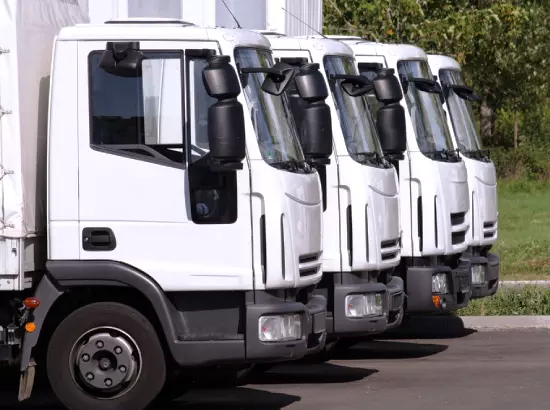
Straight trucks are extremely versatile and are known to be an important asset to various types of companies, such as trucking companies, freight forwarders, manufacturers and others. Let’s take a closer look at some of the most impactful benefits that straight trucks have.
- Easy to Operate – Compared to tractor-trailers and semi trucks, straight trucks are much easier to operate, as the cab and the cargo component are attached to a single frame. That makes operating straight trucks much more convenient and also easier to learn.
- Increased Safety – Trucks with separate trailers require an optimal load distribution to avoid fishtailing. As straight trucks are defined as having all axles attached to a single frame, there is no risk of fishtailing and are therefore also safer to drive.
- Reasonable Maintenance Costs – Operating a fleet of straight trucks is also affordable to maintain. Straight trucks do not have fifth wheels and lock handles that need to be maintained and replaced. Moreover, light to medium-duty straight trucks often has simple engine designs that require little maintenance.
- No CDL Requirements – Straight trucks that have a gross vehicle weight less than 26,001 lbs (class 3, 4, 5 & 6) do not require a commercial driver’s license, in order to be operated. This also allows for easier driver rotation and management.
- Large Load Capacity – Straight trucks have a large cargo hold and a sturdy frame that can support a total load capacity of up to 54,000 lbs (class 8a). In turn, this means that the operating costs per mile can be heavily reduced, the more the truck is utilized with backhaul trucking for example.
- Affordable – As straight trucks come in various configurations and lengths, they have an affordable entry price. Therefore, companies such as freight forwarders, manufacturers or trucking companies can choose from a wide range of different straight trucks to suit their needs.
- Low Space Requirements – The space needed to park straight trucks is also less compared to tractor-trailers, as both tractors and trailers are typically stored in separate locations.

Get Free Course Access
If you enjoyed the article, don’t miss out on our free supply chain courses that help you stay ahead in your industry.

Andrew Lin
Co-Founder & Writer
at freightcourse
About the Author
Andrew is a multi-business owner with over 12 years of experience in the fields of logistics, trucking, manufacturing, operations, training, and education.
Being the co-founder of freightcourse has given him the ability to pursue his desire to educate others on manufacturing and supply chain topics.
Follow us